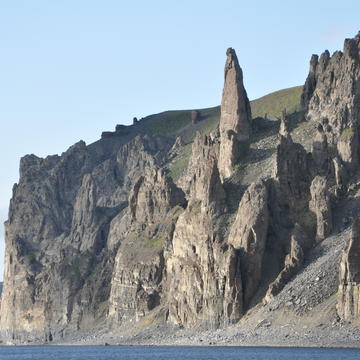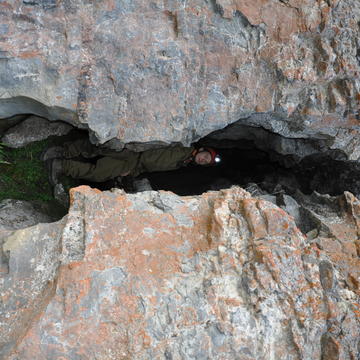A permafrost-free Arctic region when global temperatures were 4.5˚C higher than today

Taba-Ba’astakh Cliffs, Northern Siberia
Scientists have found evidence that the Asian continent was free of permafrost all the way to the Arctic Ocean when Earth’s average temperature was 4.5˚C warmer than today. Unlike the present day, the results suggest dominantly permafrost-free conditions across the whole Northern Hemisphere during this time period. The stark findings indicate that if global temperatures were to rise by this amount in the future, permafrost found in the Northern Hemisphere would thaw. Such a temperature increase would release up to 130 billion tonnes of carbon currently frozen in the ground over the coming decades.
The international team of researchers led by Northumbria University, which included Gideon Henderson and Andrew Mason of Oxford Earth Sciences, came to this conclusion after studying more than 60 mineral deposits obtained from caves in the Lena River delta region of north-eastern Siberia. The findings were published this week in Nature Communications.
Cave mineral deposits such as stalagmites and stalactites can only form when rain and snow meltwater seep through soil and rocks, slowly forming deposits in caves below the ground. These deposits cannot form when the ground above the caves is frozen, as it is today across large areas of Siberia and other regions bordering the Arctic Ocean.
The study relies on a high-precision technique which uses the radioactive decay of naturally occurring uranium in the deposits to form lead (so called uranium-lead dating). By measuring the tiny amounts of these elements in facilities here at the University of Oxford, the authors of the study were able to date the past cave minerals and determine the age of the deposits from caves in the Taba-Ba’astakh cliffs. The minerals formed in the far north of Siberia 8.7 million years ago during the late Miocene period. The presence of cave deposits at this time indicates that the ground temperature was above 0˚C and permafrost was absent, allowing water to filter through the soil.
Existing records from other regions demonstrate that, at that time in the past, average global temperatures were 4.5˚C higher than those experienced today. This indicates that warming of 4.5˚C is sufficient to melt the vast majority of permafrost in the Northern Hemisphere, with permafrost-free conditions extending all the way to the northerly coast between Asia and the Arctic Ocean. Today’s permafrost contains vast amounts of carbon, captured as dead plant material is frozen into the soil layer. Thawing of the permafrost would release this carbon back to the atmosphere to further increase warming.
“Caves can be our time machines. They capture a history of the climate and environment for millions of years of Earth history, which we can now read accurately using precise chemical analyses. By doing so, we can predict the future, using past conditions as an analogue for the future to understand the impact of the warmer world we are heading into. This new study provides valuable new constraints on the magnitude of warming required to completely destroy permafrost in the Northern Hemisphere and remove one of the biggest continental stores of carbon.”
- Professor Gideon Henderson

Co-author Dr Sebastian Breitenbach (Northumbria University) explained “Our findings provide direct quantitative evidence that if our climate warms by 4.5˚C, the permafrost currently covering Canada, Siberia, Mongolia, America – in fact much of the Northern Hemisphere – would thaw. Only permafrost in high mountains and deep underground would survive. This thaw would release billions of tonnes of carbon from the ground into the atmosphere, enhancing further warming. This finding is a real warning to us all. It shows how sensitive our climate system is and where we might be headed if we don't act to limit our climate emissions now."
Dr Anton Vaks (lead author, Geological Survey of Israel) said “After much searching, we were fortunate to find well-preserved datable cave deposits in the heart of today’s Siberian permafrost. We can see that this present-day tundra region experienced a warmer climate, with mean annual global temperatures above 0°C and with permafrost-free conditions. This indicates that most of the Siberian landmass and likely similar regions in the Northern Hemisphere were permafrost-free when the deposits formed at Taba-Ba’astakh.
The paper 'Arctic speleothems reveal nearly permafrost-free Northern Hemisphere in the late Miocene' is available to read in the journal Nature Communications at https://doi.org/10.1038/s41467-025-60381-5. The study was funded by the Natural Environment Research Council and the Leverhulme Trust.




